We have moved to a new server!
Since March 2014, this website has been moved to this new server: http://web.ntnu.edu.tw/~treehopper/. This page will not be updated anymore. Please update your browser’s bookmark or the web links.
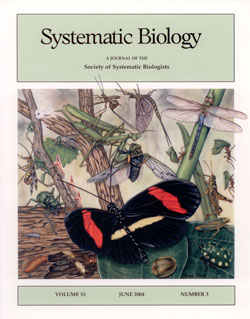
Systematic Biology 2004 vol.53 isssue 3 cover featured treehoppers (and other insects) (Lin et al 2004).
Research
Table of Content
Research
1. Treehopper Biology
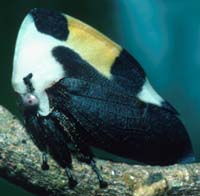
A female Membracis treehopper from Chiriqui Grande, Panama, 2000. (photo by CPL)
Treehoppers (Insecta: Hemiptera: Membracidae) are a group of small herbivorous insects with piercing and sucking mouthparts used to feed on plant sap of the phloem and xylem. Most treehoppers can be easily recognized among similar insects (such as leafhoppers, planthoppers, and spittle bugs) by the presence of an often enlarged and bizarr-looking structure (pronotum) above the thorax. Treehoppers, like most hemipteran insects, have midgut filter chambers that allow extraction of nutrients (primarily amino acids and carbohydrates) from plant sap. Excess fluid containing nutrients is excreted in the form of honeydew, which in many treehoppers is collected by social hymenopterans such as ants, meliponine bees, and wasps. Because of honeydew production, treehoppers and ants frequntly form mutualistic relationships in which treehopper gain a benefit of protection from ant atendance. (Read more about treehoppers in Wood 1993, Lin 2006)
2. Vibrational Communication
In group-living treehoppers, substract-brone vibrational signals are important for solving the challenges of life on their host plants. In some species, nymphs (immatures) signal to mothers about the approach of a predator. In other species, individual treehoppers signal to their siblings after discovering a feeding site. And other treehoppers produce vibrational signals whose functions are still unknown. In collaboration with Reginald Cocroft of University of Missouri-Columbia, a research project funded by the National Geographic Society revealed remarkable communication systems in nymphs of membracine treehoppers. (see & listen to 'A Journey to the Edge of the Amazon' featured in NPR Morning Edition of May 24, 2006). These discoveries provide an unique window into how communication systems evolve in concert with social behavior and ecology of treehoppers.
3. Molecular Systematics & Phylogenetics
“ The species phylogeny is more like a statistical distribution, being composed of various trees (the gene trees), each of which may indicate different relationships. ”
—Wayne Maddison, 1995
i. Treehopper Subfamily Membracinae
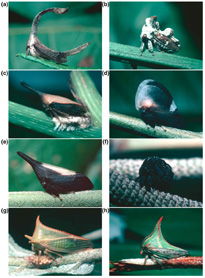
Representatives of the membracine treehoppers (from Lin et al 2004).
One of the goals of systematic biology is to investigate the relationships and evolutionary histories of organisms. A higher-level phylogenetic analysis of the Neotropical treehopper subfamily Membracinae (including nearly 447 named species, 38 geneara, 5 tribes) based on large mitochondrial and nuclear DNA data sets recovered all four tribes and resolved the generic and tribal relationships within the Membracinae with strong supports (Lin et al 2004 ).
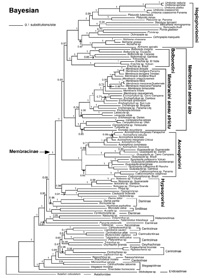
Membracine phylogeny derived from molecular characters (Lin et al 2004).
ii. Phylogeny of Enchenopa binotata species complex
(In progress ...)
iii. Phylogenetic Utility of Molecular Characters
(In progress ...)
iv. Phylogeny of Taiwanese Lucanus stag beetles
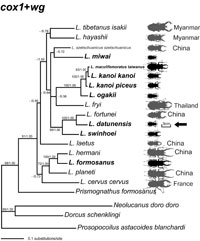
Taiwanese Lucanus phylogeny (from Lin et al 2009).
Lucanus datunensis is Taiwan’s smallest and most threatened stag beetle species. It currently exists as only one population located in tall grasslands of Mt. Datun in the Yangmingshan National Park. Phylogenetic analyses suggest L. datunensis being sister to L. fortunei from China. Low mitochondrial DNA diversity indicates a small effective population size (Lin et al 2009 ).
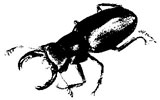
Lucanus datunensis (drawing by Hsuan-Yu Peng).
4. Character Evolution
i. Evolution of Maternal Care
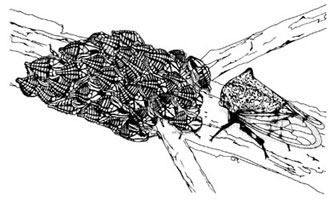
A Metcalfiella nigrihumera female guarding her nymphal aggregation (drawing by CPL).
Many treehopper species are group-living organisms and they exhibit variation in social behavior ranging from solitary individuals, nymphal or adult aggregations to highly developed maternal care with parent-offspring communication. Subsocial behavior in treehoppers is restricted to maternal care of eggs and nymphs. Egg-guarding is the most common form of maternal care in treehoppers. The variation in social behavior among closely related species within the Membracinae provides an excellent opportunity for addressing a number of important questions in insect social evolution (Lin et al 2004, Lin 2006). Results of a comparative analysis of maternal care in treehoppers were used as an example in a classic textbook of behaviour (Chap. 12, p. 406-08, Animal Behavior: An Evolutionary Approach, 8th ed. 2005 by John Alcock)
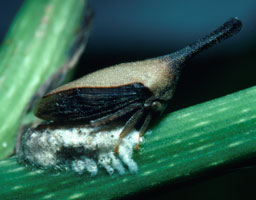
A Guayaquila female standing guard over a cluster of eggs inserted into the stem of the plant and covered a waxy secrection applied by the female. Photo by CPL.
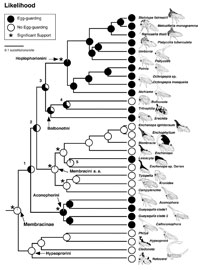
Evolutionary transition of maternal care in the Membracinae (Lin et al 2004).
5. Phylogeography
i. North American Oak Treehoppers
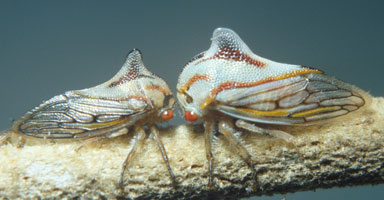
Platycotis tuberculata, a teneral male on the left & female on the right, from La Union of Honduras, 2001. Photo by CPL.
Through studying the contemporary geographic distribution of gene genealogies in natural populations, phylogeography provides a unified conceptual framwork for investigting historical processes of species formation and diversification. We studied the phylogeography of the North American oak treehopper, Platycotis vittata and examed the concordance between the phylogeographic pattern and genetic structure predicted by a temporal isolation hypothesis (Lin et al 2007). Our phylogeographic analyses revealed the presence of substantial genetic variation within the North American P. vittata that matches closely to a large scale geographic distribution of the Eastern US, Ozark Plateau, and Western US lineages. The results of no apparent phylogeographic substructuring and a low level of gene flow among northern and southern populations of the Eastern US clade are in concordance with this hypothesis of temporal isolation without fixed genetic changes.
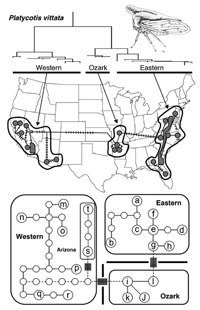
Phylogeographic pattern of the North American oak treehoppers (Lin et al 2007).
ii. Philippines Archipelago
(In progress...)
iii. Endemic Taiwanese Insects
Taiwan is unique among all subtropical regions because it is the only sizeable island located immediately north or south of the tropical zone between the 23rd parallels. We studied the phylogeography of selected endemic Taiwanese insects to investigate their origins and diversification within the island.
a. Phylogeography and Mandible Evolution in Lucanus formosanus
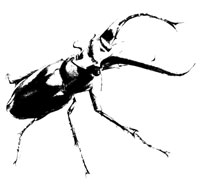
Lucanus formosanus (drawing by Hsuan-Yu Peng).
This study reveal that L. formosanus originated nearly 1.6 million years ago (Mya) in the early Pleistocene period and consisted of geographically overlapping Alishan and Widespread clades. A drastic population expansion starting approximately 0.2 Mya in the Widespread clade likely resulted from altitudinal range shift of the temperate forests. A ring-like pattern of historical gene flow among neighboring populations in the vicinity of the Central Mountain Range indicates that the mountains constitute a strong vicariant barrier to the east–west gene flow of L. formosanus populations. The degree of mandible variation does not correlate with the expected pattern of neutral evolution, indicating that the evolutionary diversification of this morphological weapon is most likely subject to sexual or natural selection (Huanag & Lin 2010).
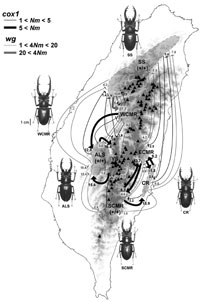
A ring-like pattern of historical gene flow in L. formosanus (Huanag & Lin 2010).